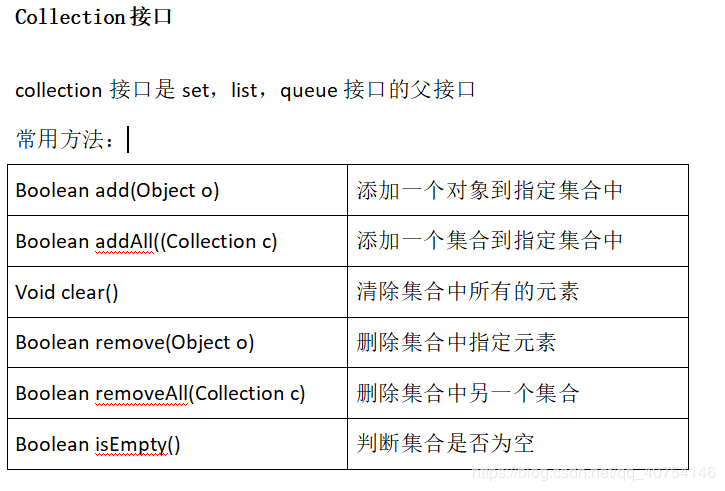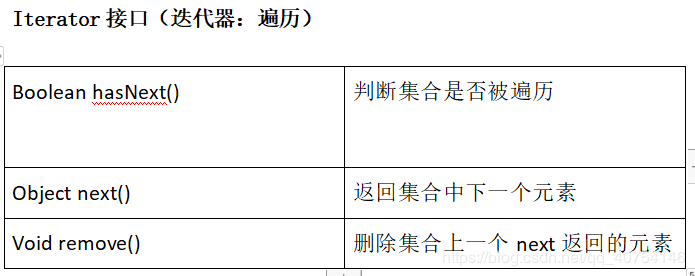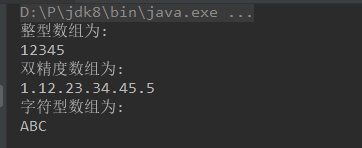Preface:
For object-oriented languages, in order to operate more than one object conveniently, it is necessary to store the object.
The biggest problem with using arrays to store objects is the fixity of array length. (inflexible, difficult to expand)
Java collections, also known as containers, can dynamically store references to objects in containers. (Flexible and extensible)
Set and array distinction
Array:
You can store the same basic data type or reference data type
Length Fixed
Collection:
- Different types of elements can be stored, but they must be reference data types
- Variable length
Overview of collections
Java collection classes are mainly derived from Collection and Map. Collection is an interface, a highly abstracted collection, which contains the basic operations and attributes of the collection; Map is a mapping interface, that is, key-value key-value pairs.

Collection
- List orderly repeatable
- ArrayList
- LinkedList
- Vector
- Stack
- Set disorder is not repeatable
- HashSet
- LinkedSet
- TreeSet
ArrayList - LinkedList - Vector- Stack features
- ArrayList: Asynchronous, thread insecurity, high efficiency of execution; the bottom use of arrays, storage and reading efficiency, insertion and deletion efficiency is low
- LinkedList: Asynchronous, bi-directional linked list, insertion and deletion efficiency
- Vector: Synchronization, thread safety, low execution efficiency
- Stack: Inherit Vector
From the perspective of data growth:
Array List and Vector use arrays to control objects in collections.
When you add elements to both types, if the number of elements exceeds the current length of the internal array, they all need to extend the length of the internal array.
Vector automatically doubles the array length by default, and ArrayList is 50% of the original.
So if you want to save a lot of data in a collection, there are some advantages to using Vector.
HashSet-LinkedSet-TreeSet Features
HashSet is implemented by HashMap, which has strong access and search performance.
LinkedHashSet inherits HashSet.
TreeSet provides an implementation of storing Set interfaces using tree structure. Objects are stored in ascending order, and access and traversal time is very fast. The bottom layer is TreeMap.
Map
- HashMap
- TreeMap
HashMap - TreeMap features
HashMap is usually faster than TreeMap (because of the data structure of trees and hash tables). It is recommended to use HashMap more often than TreeMap when sorting is needed.
HashMap results are not sorted, while TreeMap outputs are sorted.
Common methods of Collection interface and Iterator interface


Simple use:
1.HashSet
import java.util.Date;
import java.util.HashSet;
import java.util.Iterator;
public class Main {
public static void main(String[] args) {
Date currentDate = new Date();
HashSet hs= new HashSet();
//Adding elements
hs.add(currentDate.toString());
hs.add(new String("2"));
hs.add("3");
hs.add("3");//Cannot contain duplicate elements, automatically overwritten
System.out.println("for Iterative output");
for(Object element:hs)
{System.out.println(element); }
System.out.println("Iterator Iterative output");
Iterator iterator=hs.iterator();
while(iterator.hasNext())
{
System.out.println(iterator.next());
}
//Delete elements
hs.remove("2");
hs.remove(currentDate.toString());
System.out.println("After deleting the element, output:");
for(Object element:hs)
{
System.out.println(element);
}
}
}
2.TreeSet
//TreeSet default automatic sorting
import java.util.TreeSet;
import java.util.Iterator;
public class Main {
public static void main(String args[]) {
TreeSet tr = new TreeSet();
tr.add("B");
tr.add("A");
tr.add("D");
tr.add("E");
System.out.println("Direct Output Set Objects");
System.out.println(tr);
System.out.println("for Ergodic output");
for (Object element : tr) {
System.out.println(element);
}
System.out.println("Iterator Iterative output");
Iterator iterator = tr.iterator();
while (iterator.hasNext()) {
System.out.println(iterator.next());
}
}
}
3.LinkedList
import java.util.LinkedList;
import java.util.Iterator;
public class Main
{
public static void main(String []args)
{
LinkedList li= new LinkedList();
li.addFirst("C");
li.addLast("D");
li.addFirst("B");
li.addLast("E");
li.addFirst("A");
li.addLast("F");
System.out.println( "Direct Output");
System.out.println(li);
System.out.println("--------------------");
System.out.println( "use for output");
for(Object str:li)
{System.out.println(str);}
System.out.println("--------------------");
System.out.println( "Using Iterator Output");
Iterator iterator= li.iterator();
while(iterator.hasNext())
{System.out.println(iterator.next());}
System.out.println("--------------------");
System.out.println("Visit");
System.out.println("peekFirst:"+li.peekFirst());//getFirst,getLast
System.out.println("peekLast:"+li.peekLast());
System.out.println("delete");
System.out.println(li.removeFirst());//pollFirst,pollLast
System.out.println(li.removeLast());
System.out.println("--------------------");
System.out.println("use for output");
for(Object str:li)
{System.out.println(str);}
System.out.println("--------------------");
}
}4.ArrayList
import java.util.ArrayList;
import java.util.Iterator;
public class Main
{
public static void main(String []args)
{
ArrayList list = new ArrayList();
list.add("A");//Appends the specified element to the end of this list
list.add(1,"B");//Point location of insert list
list.add("C");
list.add("D");
list.add("E");
//for traversal
System.out.println("for ergodic");
for(Object element:list)
{
System.out.println(element);
}
System.out.println("------------------");
//Iterator traversal
//Obtaining iterators
System.out.println("Iterator traversal");
Iterator iterator = list.iterator();
//If there are still elements that can be iterated, return true.
while(iterator.hasNext())
{
System.out.println(iterator.next());// Returns the next element of the iteration.
}
System.out.println("------------------");
//Delete element remove
System.out.println("Before deletion:");
for(Object element:list)
{
System.out.println(element);
}
list.remove(0);
list.remove(2);
System.out.println("------------------");
System.out.println("After deletion:");
for(Object element:list)
{
System.out.println(element);
}
}
}5.HashMap
import java.util.HashMap;
public class Main
{
public static void main(String []args)
{
HashMap hs = new HashMap<>();
//Write data
System.out.println("Write data...");
System.out.println("...");
hs.put(1,"Huachenyu");
hs.put(2,"Jay Chou");
hs.put(3,"Liu Ruoying");
hs.put(4,"Xu Song");
//Read data
System.out.println("Read data...");
System.out.println("...");
System.out.println(hs.get(1));
System.out.println(hs.get(2));
System.out.println(hs.get(3));
System.out.println(hs.get(4));
//Delete data
System.out.println("...");
System.out.println("Delete data...");
hs.remove(1);
System.out.println(hs.get(1));
}
}Summary:
There are many kinds of implementations of collections, but one thing remains unchanged. The main function of collections is to store and manipulate objects. The correct way to open collections is to cooperate with specific application scenarios according to the storage mode and operation performance characteristics of specific implementations.
Problems caused by set universality
When an element is dropped into a collection, the collection is compiled into an Object class for better generality.
The resulting problems:
- Exceptions saved by different objects to the same specified set
- Mandatory Type Conversion Exceptions Caused by Extracting Elements from a Collection
What is generics?
Parametric type!!!
What is a parameterized type???
Specific types (such as String, Integer) are abstracted into parameters.
The role of generics
- Eliminates mandatory type conversions in collections and reduces exceptions.
- The restricted type of object is specified, and the type security of Java is realized.
- Merge code. Increase reuse rate.
The manifestation of generics
Rhombic grammar:
List<String> list = new List<>(); Map<Integer , String > = new Map<>();
generic class
//generic class
public class Main<T>
{
private T data;
public Main(T data)
{
this.data=data;
}
public T getData()
{
return data;
}
public static void main(String []args)
{
Main<Integer> g1 = new Main<Integer>(1222);
System.out.println(g1.getData());
Main<Double> g2 = new Main<Double>(1222.1222);
System.out.println(g2.getData());
Main<String> g3 = new Main<String>("cat");
System.out.println(g3.getData());
}
}
generic method
public class Main
{
public static <E> void printArray(E inputArray[])
{
for(E element:inputArray)
{
System.out.printf("%s",element);
}
}
public static void main(String args[])
{
Integer intArray[]= {1,2,3,4,5};
Double doubleArray[]= {1.1,2.2,3.3,4.4,5.5};
Character charArray[]= {'A','B','C'};
System.out.printf("The integer array is:\n");
printArray(intArray);
System.out.printf("\n");
System.out.printf("The double precision array is:\n");
printArray(doubleArray);
System.out.printf("\n");
System.out.printf("The character array is:\n");
printArray(charArray);
System.out.printf("\n");
}
}
generic interface
public interface TestInterface<T> {
public T next();
}
import java.util.Random;
public class Main implements TestInterface<String>
{
String list[]={"L","A","C"};
@Override
public String next()
{
Random rand = new Random();
return list[rand.nextInt(2)];
}
public static void main(String[] args)
{
Main obj = new Main();
System.out.println(obj.next());
}
}
